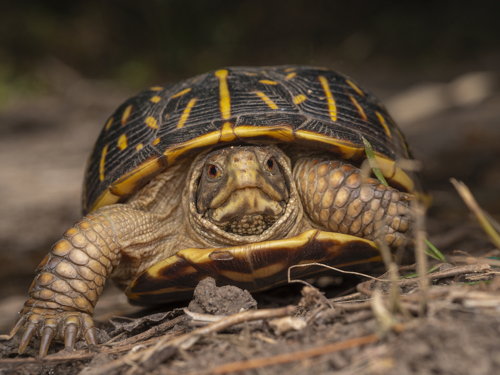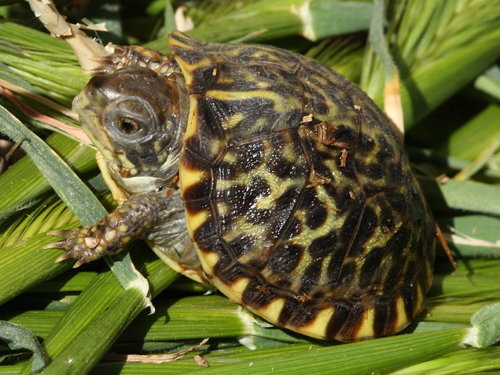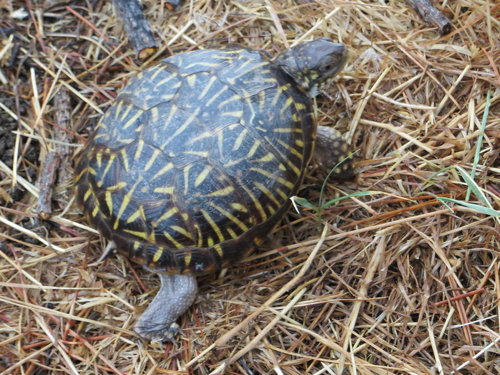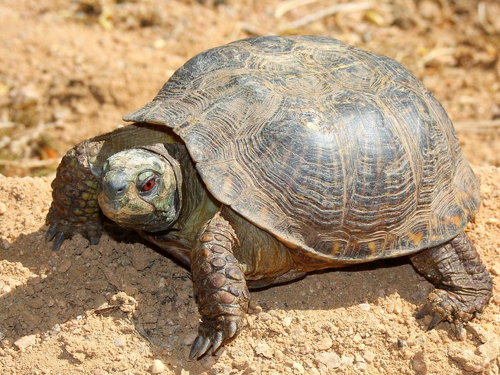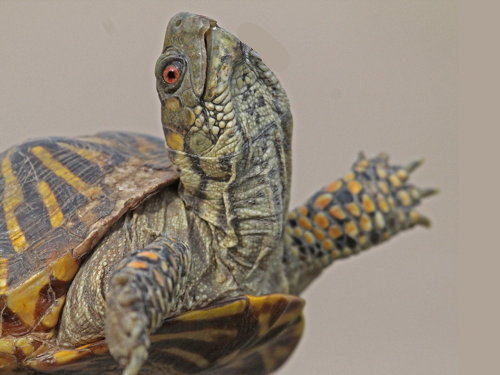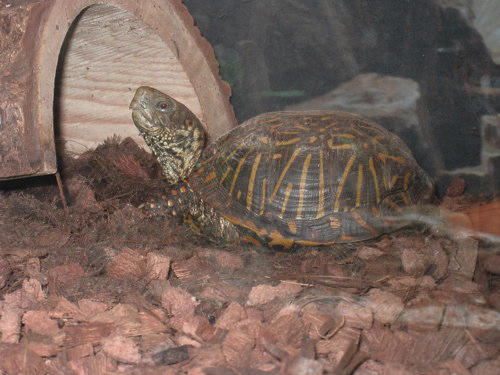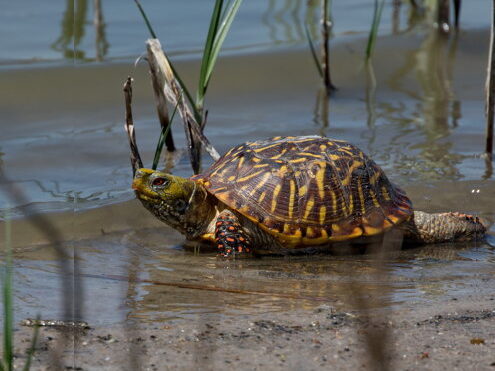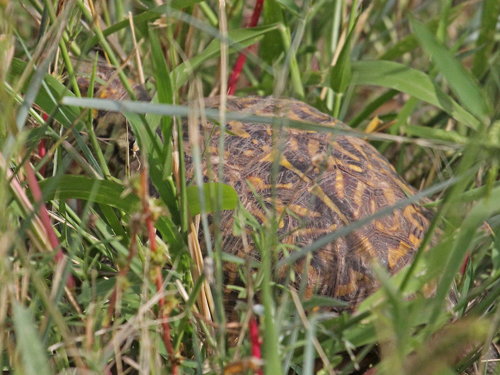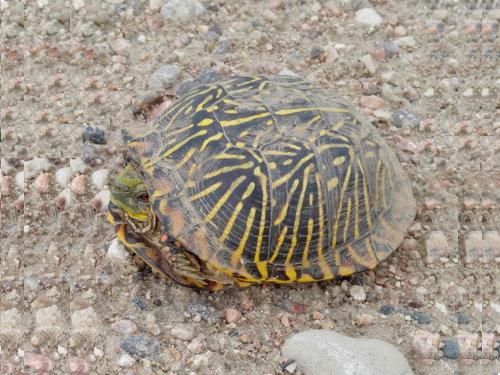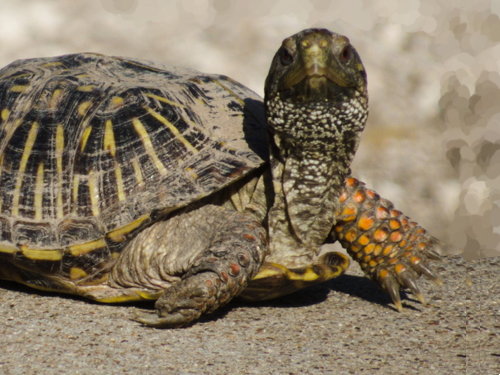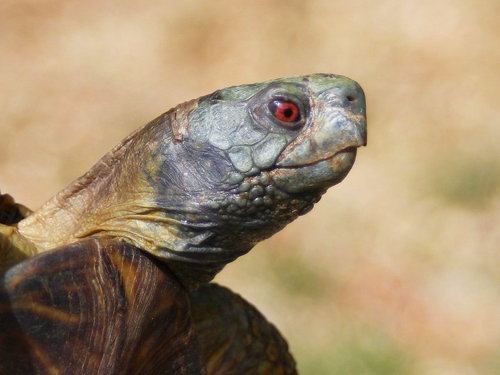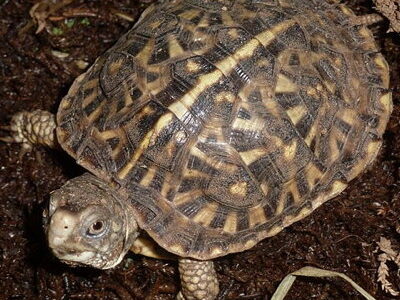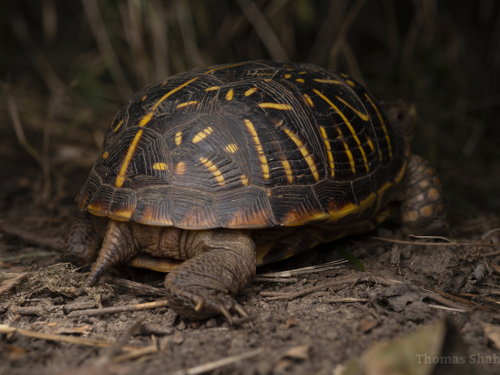Western Box Turtle
Scientific name: Terrapene ornata
Type: Reptitle
Family: Emydidae (Pond and Marsh Turtles)
Size: 3.7 to 5.9 inches length
Weight: 7 to 20 ounces
Life Span: up to 40 years
Physical Description
The western box turtle is a land turtle with a high domed shell that appears to be slightly flattened compared to other box turtles. The shell has both a narrow keel lengthwise down the center and some flaring at the rear edge. The bulk of the turtle’s shell, tail, head, and limbs are mostly dark brown or black in color. The shell is marked with radiating yellow lines. As the animal ages, the shell lightens in color with the line fading. Older adults often have a plain yellow-brown shell.
There are two subspecies of western box turtle in New Mexico — Terrapene ornata ornata known as the ornate box turtle and Terrapene ornata luteola or the desert box turtle. The two subspecies are very similar but do have different shell markings as shown in the photo below. It is unclear whether there are actually any native box turtles in Los Alamos county. Although some have been spotted, they may be former captives.
Females tend to be slightly larger than males. Adult females usually have orange-brown or yellow irises whereas males typically have red irises. In addition, the first nail on each hind foot on a male curls inward. Males have a concave dip within their plastron which helps the fella out during reproduction. Females tend to have a flat plastron or underside while females generally have a flat plastron.
Ornate (T. o. ornata) versus Desert (T. o. luteola) Subspecies
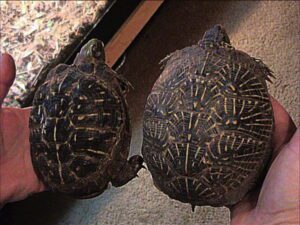
Range and Habitat
The western box turtle is a North American species with a range that covers the southwestern and central United States between the Rocky Mountains and the Mississippi River. It can be found as far north as Wisconsin and South Dakota and as far south as parts of northern Mexico. T. o. luteola (desert box turtle) is more common along the southwestern parts of the range whereas T. o. ornata (ornate box turtle) is more common in the central US.
Western box turtles typically live in areas with sandy plains and grasslands with some low bush vegetation and far from a body of water. These turtles usually spend their whole lives in a small area (less than a few acres). The desert box turtle inhabits drier areas than the ornate.
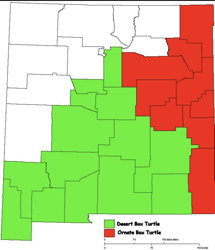
green = desert; red = ornate
Diet
The western box turtle is an omnivore, eating whatever is available at a given time — insects, spiders, worms, carrion, fruits, vegetables, and berries. However, mulberries are a particular favorite. These turtles will grasp captured food by the jaws swallowing it whole or tearing it apart with help from the front claws.
Behavior and Social Life
Western box turtles are terrestrial, though they spend most of their lives underground in burrows to escape temperature extremes. In the fall, they will dig a hole for hibernation during the winter.
These turtles are active during the day, particularly in the spring and fall. During the summer, they tend to come out in the morning and after rain to bask in the sunshine and feed. They are not particularly sociable as they tend to interact only during mating.
Sitting and Hiding
Life Cycle
Western box turtles mate throughout their active season (April through October). Males will chase after the female for as long as half an hour, and eventually, the winning male will mate with the female. Both males and females may mate with several different members of the opposite sex during one season. Also, females are able to store and use sperm for the later fertilization of eggs. There are usually only one or two clutches laid per season.
Four to five eggs are typically laid from May to July in a sandy nest. The western box turtle eggs are relatively large compared to other species. The eggs usually incubate unattended for about 50 days. Warmer temperatures tend to lead to shorter incubation times and moister environments lead to larger hatchlings. 8°C, they tend to be male.
Hatchlings are well-developed at the time of birth. However, many do not survive to sexual maturity at about 8 years old for females and 5 years old for males.
Adult
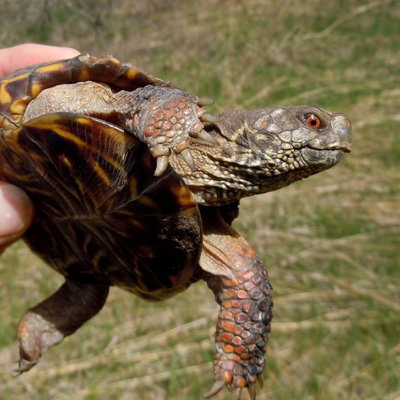
Juvenile
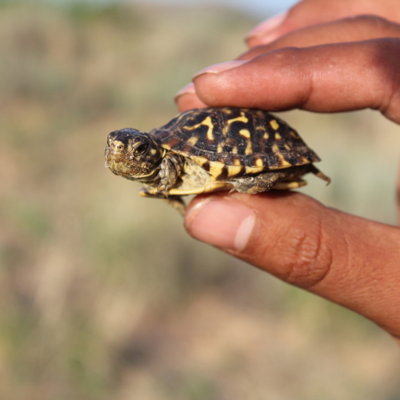
Ecological Role
The varied diet of the western box turtle means represents little competition for available food resources with other animal species. However, since it lays its eggs on land and often leaves them unattended, the eggs and juveniles are often preyed upon by other animals like coyotes and raccoons.
Interactions With Humans
Western box turtles are economically important as a source of pet trade for humans despite being protected in many states. In addition, human-related habitat destruction has led to the western box turtle being considered threatened according to the IUCN Red List.
They are not known to have a negative impact on humans, though they may bite if threatened.
Interesting Facts
- Box turtles have a unique hinged shell that allows them to completely close up.
- Box turtles can eat poisonous mushrooms to make their skin poisonous to predators.
- They are not aggressive and will freely walk around neighboring territories.
- These turtles will hide during the hottest part of the day under logs or in abandoned burrows.
- The shell of a box turtle keeps growing throughout its life.
- The shell of a young turtle may be relatively soft for up to 7 years.
- Male box turtles may have a concave dip within the underside of their shell to aid in mating.
- Females are able to store and use sperm for fertilization of eggs for up to 4 years.
- Hatchlings are generally females at temperatures above 84°F and usually male below 82°F.

